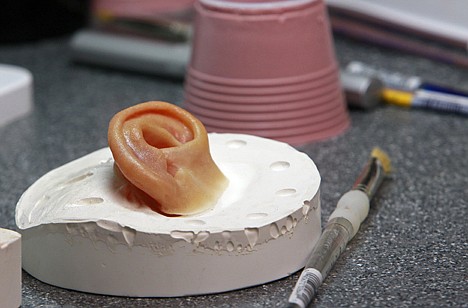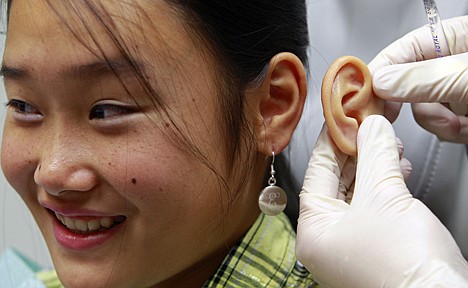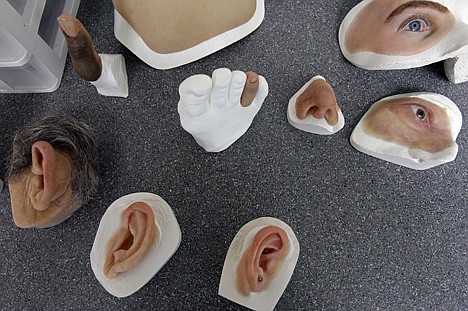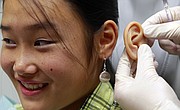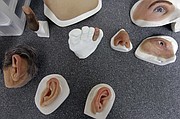Hollywood-style special effects give girl new ear
WASHINGTON - Elise Lutz never let her friends see what was left of her ear.
She would carefully style her long hair into a one-sided ponytail, or swelter under a swim cap for hours at meets, to cover the molten lump from a severe burn as a toddler in her native China.
But as a teenager, the North Carolina girl expressed her desire to be whole again with a simple request: She really wanted pierced earrings. Thus began a months-long quest for a new right ear, one made of silicone but so lifelike that it even glows a bit in the sun like real skin.
Elise benefited from a little known field called anaplastology, where medical artists make Hollywood-like special effects come alive to fix disfigurements that standard plastic surgery cannot.
"It kind of took forever, but it was worth it," says Elise, 14, as she headed to show her transformation to her dad and sisters. "I'm so excited, I'm more than 100 excited."
No messy glue-on prosthetic that she might accidentally knock off. Elise had tried that once and hated it. This time, she would go under the knife to have rods implanted in her skull to snap her new ear into place - and hold it even when this passionate swimmer dives into the pool.
"People who have implant-retained ears or noses or whatever usually think of them really as their own body," says Jerry Schoendorf, who with his colleague at The Anaplastology Clinic in Durham, N.C., - and surgeons at nearby Duke University Medical Center - created Elise's ear.
"It's the Rolls Royce of what we can offer," adds fellow anaplastologist Jay McClennen.
Facial prosthetics - made to counter damage from cancer, trauma, birth defects - haven't gained the attention of artificial legs and arms. The specialists who craft them can be hard to find: The International Anaplastology Association counts just 150 members worldwide.
But facial prosthetics are becoming more realistic and longer-lasting, and Elise's journey offers a glimpse of the tricks that help: Titanium rods adapted from dentistry that bond with bone to hold them in place. More flexible silicones. Even "flocking," using those nylon particles that make the velvety insides of jewelry boxes can help give silicone "skin" more dimension - and not in flesh tones, but flecks of bright reds, plums, blues, oranges.
Patients "can't believe all those colors go into making that skin," says McClennen, who now fixes faces using techniques honed in previous careers to "age" actors in the movies, and in forensic reconstruction.
No one knows for sure how Elise was burned. Probably, boiling water sloshed down her head and right side, says Kim Williams of Wake Forest, N.C., who with her husband adopted Elise from a Chinese orphanage at age 9. Plastic surgery enabled hair to cover the scar-riddled right side of her scalp, a shield as Elise learned English and met new friends.
Plastic surgeons started but abandoned ear reconstruction. Prosthetics made to glue on daily are a more common option, especially for cancer patients whose doctors need to regularly check for recurrences. But that didn't work for Elise. Her scars interfered with a straight fit, and crusty adhesive lined edges where she didn't clean the prosthetic well enough.
Then Schoendorf suggested an implant-retained ear: It would cost about $8,000 to $10,000, nearly double an adhesive-retained prosthesis, plus surgery. But where a glue-on ear prosthetic might last about three years before wearing out, the implant-retained one should last twice as long, he says. Replacements will fit onto those same rods, making surgery a one-time hurdle.
In June, Schoendorf and McClennen made a precise mold of where a new ear implant would need to fit. With the residual ear tissue carefully removed, Duke otolaryngologist Dr. David Kaylie then drilled tiny titanium posts into Elise's skull. They barely emerge from the skin.
Over the next few months, bone cells called osteoblasts will fuse with the titanium to anchor those rods, he told her.
"If you wiggle it while it's healing, that prevents those osteoblasts from growing in," Kaylie cautions. "They really have to keep their hands off."
Back at The Anaplastology Clinic, McClennen was sculpting the ear that eventually would hook onto those rods with a mere three clicks. Elise's has a bar on the back to snap it on; noses especially are starting to be made with magnets for attachment.
Coloring brings out the true art. In the 1990s, as part of a team working on movies like "Nixon" and "Legends of the Fall," McClennen learned to impregnate colorless silicone with a mix of colors so the finished prosthetic required only thin glazing and not heavy paint. Harder acrylic threaded through the rubbery silicone like cartilage holds the retention bar and, with a technique gleaned at a cancer center in Toronto, McClennen used the right color to mimic that red glow when sunlight shines behind the ear.
Blending where the edges meet real skin is crucial, as is managing expectations, Schoendorf says: "As good as it is, it's not perfect."
The day before Thanksgiving, Elise's new ear is ready to attach, complete with earring hole. She practices clicking it on, surprised that it's easy, and smiles into the mirror, hair tucked back.
"This one looks fantastic," she later proclaims.
Lauran Neergaard covers health and medical issues for The Associated Press in Washington.


